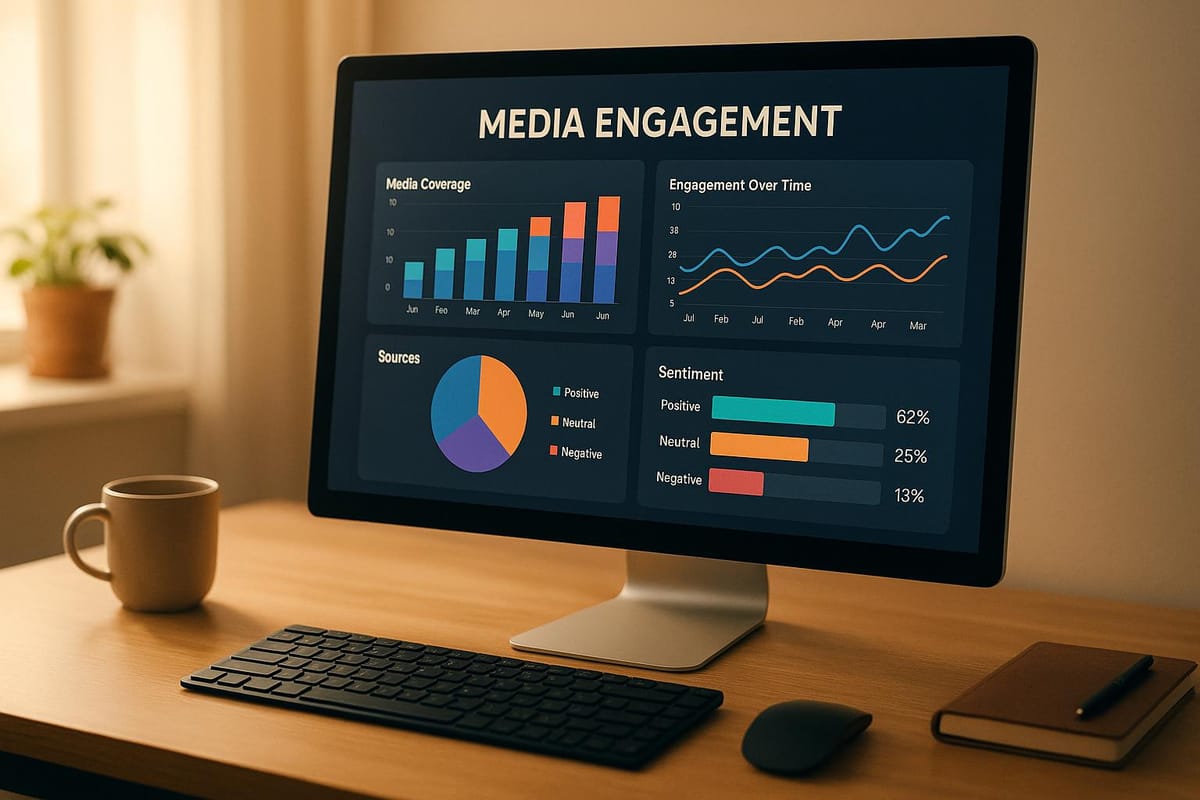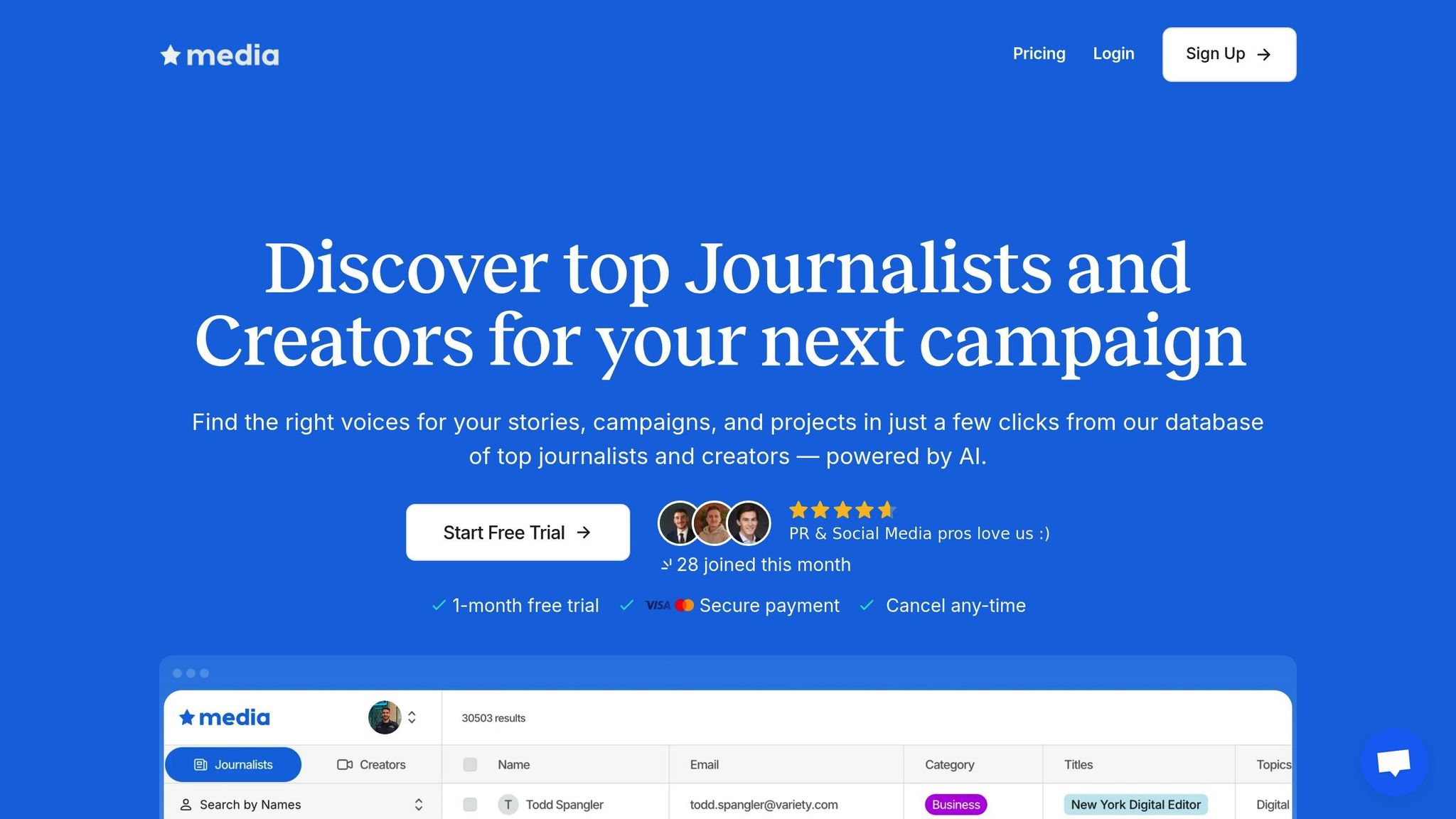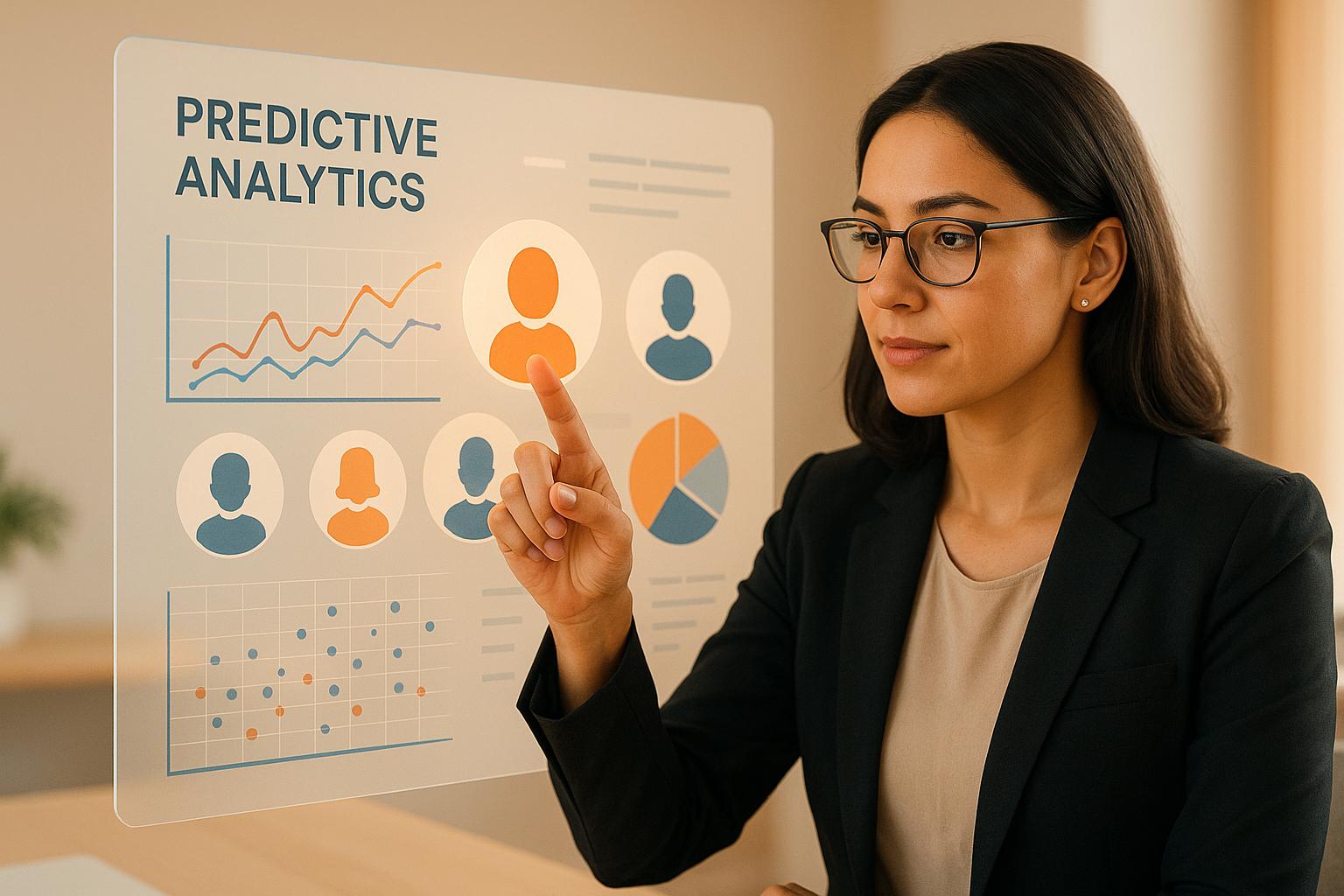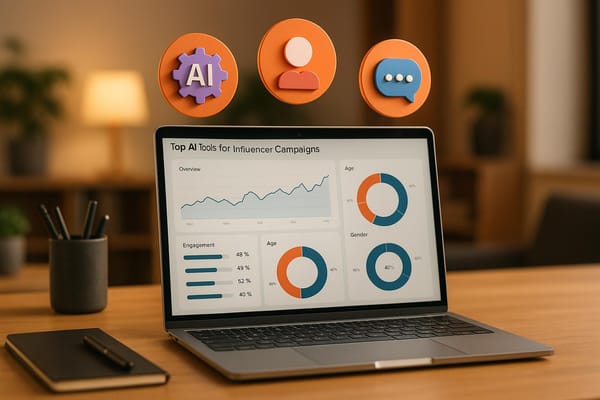How to Analyze Media Coverage Engagement with AI
Explore how AI is revolutionizing media engagement analysis, offering insights into audience behavior, sentiment, and effective strategies.

AI is transforming how we analyze media engagement. It helps PR and marketing teams dive deep into audience behavior, sentiment, and trends across platforms - far beyond just counting mentions. Here's what you need to know:
- Key Metrics: Track reach, impressions, engagement rates, sentiment, share of voice, and virality to measure performance effectively.
- AI Tools: Automate data collection, sentiment analysis, and trend tracking to save time and improve accuracy.
- Actionable Insights: Use AI to identify opportunities, predict trends, and refine strategies in real-time.
- US Market Focus: Tailor metrics and outputs to American preferences, ensuring compliance with privacy laws like CCPA.
AI-powered tools like Media AI simplify this process by offering features like journalist and creator databases, real-time alerts, and sentiment tracking. Whether you're monitoring campaigns or connecting with influencers, these tools make it easier to stay ahead in a fast-paced media landscape.
How to Track Content Performance With AI
Key Metrics for Measuring Media Coverage Engagement
Metrics are more than just numbers - they tell the story of your audience's size and their reactions to your content. With over half of business leaders now relying on social media data to guide their strategies, understanding these metrics has never been more crucial. They provide the foundation for diving into qualitative insights like sentiment and virality.
Understanding Reach, Impressions, and Engagement Rate
Reach refers to the number of unique viewers who see your content, while impressions include all views, even if the same person sees it multiple times. Think of reach as the breadth of your audience and impressions as the frequency of exposure.
The engagement rate measures how actively your audience interacts with your content - whether through likes, comments, shares, or clicks - as a percentage of viewers. For context, in 2024, the average daily engagements per post across industries stood at 14.
These three metrics together provide a clearer picture of your content’s performance. For instance:
- High reach but low engagement might mean your message isn’t connecting with your audience.
- High impressions but low reach could suggest your content is being shown repeatedly to the same group.
A practical example: If you achieve 10,000 impressions with a 2% engagement rate, that translates to 200 meaningful interactions - indicating your content resonates effectively.
"The only way to assess how your message is perceived is by studying the reactions to your content. Clicks, shares, or replies are the 'facial expressions' and 'words' that tell you how well your conversation is going."
- Seth Giammanco, Principal of Strategy & Technology, Minds On Design Lab
Sentiment Analysis and Share of Voice
Sentiment analysis digs deeper than simple mention counts to uncover how people feel about your brand. AI tools analyze text for emotional cues, context, and opinions, processing thousands of mentions at once. This approach captures nuances that manual reviews might miss, offering a more detailed picture of your brand’s perception.
Share of Voice (SOV) compares your brand’s presence in industry conversations against the total mentions in your space. For instance, if your industry sees 1,000 relevant mentions weekly and your brand accounts for 200, your SOV is 20%. This metric highlights your visibility and competitive position.
When paired with sentiment data, SOV becomes even more insightful:
- A high SOV with negative sentiment might indicate a brewing crisis.
- A low SOV with positive sentiment could point to untapped opportunities.
Social listening tools turn this data into actionable insights, helping you adapt your strategy based on audience chatter.
Tracking Virality and Trend Performance
Metrics like virality and trend performance go beyond basic engagement, offering a window into your content’s momentum and broader relevance.
Virality metrics focus on how quickly and widely your content spreads. AI tools monitor sharing speed, audience growth, and cross-platform reach to spot viral patterns. Key indicators include:
- Share-to-view ratios
- Growth in comments or mentions
- How fast content gains traction across platforms
For example, a post that garners 100 shares in its first hour will likely perform differently than one that reaches the same number over several days.
Trend performance examines how well your content aligns with or sparks larger conversations. AI tools track hashtags, topic clusters, and emerging themes, showing how your message fits within broader industry or cultural discussions.
Monitoring these metrics over time provides valuable insights. For instance, you might find educational content drives consistent engagement, while behind-the-scenes posts create viral spikes.
Finally, conversion metrics like click-through rates add another layer of understanding. Viral content may generate buzz, but if it doesn’t lead to actions like purchases, sign-ups, or downloads, it’s a signal to refine your strategy.
These metrics lay the groundwork for the AI-driven methods explored in the next section.
Step-by-Step Guide to Using AI for Media Engagement Analysis
Now that we've covered the key metrics, let’s dive into the practical steps for using AI to analyze media engagement. This process turns scattered data into meaningful insights that can guide your strategic decisions.
Collecting Data from Multiple Media Sources
The first step in effective media engagement analysis is gathering data from a variety of sources. AI tools shine here, pulling information from multiple channels to give you a complete view of your media presence.
Start by integrating your AI platform with diverse data sources like traditional news outlets, blogs, social media platforms, podcasts, and customer feedback channels. The goal is to ensure your AI tool can consolidate all this information smoothly.
For audio and video content, transcription services are key. These convert spoken words into text, allowing AI to analyze interviews, webinars, and other multimedia content alongside written mentions.
Think of it like financial data aggregation. For example, Goldman Sachs uses AI to process over 2.3 million daily transactions across 15 financial products. This approach helped them identify $127 million in lending opportunities that traditional methods missed and reduced loan processing times by 34%.
To refine your data, adjust filters and set parameters like keywords, demographics, and geographic regions. Once your data is collected, the next step is automating how you track and analyze it.
Automated Mention Tracking and Sentiment Analysis
With data collection in place, AI can take over the task of tracking mentions and analyzing sentiment. This automation removes the need to manually sift through countless mentions every day.
Set up keywords, including variations and industry-specific terms, and connect your social profiles to social listening tools. These tools will automatically gather customer conversations and feedback.
A great example of this is the Atlanta Hawks. They used real-time sentiment analysis to monitor the launch of their Martin Luther King Jr. Nike City Edition jersey. By setting up a system to track keywords and hashtags related to the campaign, they discovered a 99% positive sentiment rate.
Custom filters can help you focus on specific topics or sentiment trends. The AI system will then organize the data, highlight recurring themes, and flag potential issues before they become serious.
Penn State Health provides another example. They used AI-driven sentiment analysis to monitor patient conversations in real time. This allowed their team to identify negative feedback early and adjust their social strategies to address concerns.
Engagement Scoring and Trend Identification
AI doesn’t just gather data - it helps you understand it. By assigning scores to user interactions, it quantifies engagement and turns raw data into actionable insights.
The system categorizes user actions and assigns weighted scores based on their value to your business. It constantly monitors interactions and adjusts these scores as user preferences change, giving you a clear picture of engagement levels.
When it comes to identifying trends, AI processes vast amounts of data across platforms and languages. It scores trends based on factors like historical engagement, sentiment, and demographics, helping you separate real opportunities from background noise.
The results can be game-changing. Localizing national stories, for instance, has been shown to boost engagement time by 218%. Publishers who jump on emerging topics early can see three times more search traffic compared to those who wait.
To focus on the most relevant trends, define parameters such as industry-specific keywords, geographic regions, competitor lists, and alert thresholds. AI systems offer instant alerts for emerging trends and provide 24/7 monitoring. They can identify trends 2–3 weeks ahead of competitors, with an 85% accuracy rate in predicting how long those trends will last.
For the best results, use multiple AI tools, track their prediction accuracy, and adjust parameters based on performance. Combining AI insights with human judgment ensures your decisions are both data-driven and strategically sound.
AI systems can also generate daily reports, flagging significant shifts in engagement patterns. They create personalized re-engagement campaigns for users with declining activity and highlight accounts that require immediate attention due to dropping engagement scores.
How Media AI Simplifies Media Engagement Analysis

Media AI takes the guesswork out of media engagement analysis by streamlining the entire process. While AI-driven analysis can transform how PR professionals approach their work, implementing these tools effectively can feel overwhelming without the right platform. That’s where Media AI steps in, making advanced media analysis approachable for everyone in the PR world.
One of the platform’s standout strengths is its ability to connect professionals with key influencers quickly and effectively. Instead of spending hours sifting through outdated contact lists or manually researching media figures, Media AI offers an AI-powered solution that keeps up with the fast-changing media landscape.
With 75% of marketers planning to integrate AI into social media strategies to enhance customer experiences, Media AI is designed to meet this demand head-on. Its tools are practical, intuitive, and built for the needs of today’s PR teams.
Core Features of Media AI
Media AI is packed with tools that simplify media analysis and engagement. Here’s what makes it stand out:
- Extensive Database: With over 30,000 journalists and creators, Media AI helps users find the right influencers and media contacts to maximize reach and engagement.
- Advanced Filtering: Users can narrow down contacts based on beat coverage, audience size, location, and engagement metrics. This precision ensures outreach efforts are targeted and effective.
- Real-Time Alerts: Stay on top of brand mentions with instant notifications. In today’s 24/7 media environment, this feature ensures no opportunity slips by - especially important as 54% of organizations report cost savings with AI tools.
- AI-Powered Insights: The platform delivers quick summaries and sentiment trends, saving time by eliminating the need to comb through individual mentions. These insights reveal not just what’s being said, but also how audiences feel about your brand.
- Customizable PR Reports: Track key metrics like sentiment, reach, share of voice, engagement rates, and influence scores. These reports turn raw data into actionable insights you can use immediately.
- Seamless Integration: Export data effortlessly into existing workflows, making it easy to build media lists or analyze engagement trends over time.
- Accurate Contact Updates: Continuous updates ensure that contact information stays current, so you’re always working with reliable data.
Together, these features make Media AI a powerful tool for PR professionals looking to enhance their strategies without getting bogged down by manual processes.
Media AI Plans Comparison
Media AI offers flexible pricing plans to suit different needs and budgets:
| Plan | Monthly Price | Access | Key Benefits |
|---|---|---|---|
| Journalist Database | $99 | Full journalist contact database | Advanced filtering, export options, no contracts |
| Creators Database | $99 | Full creator contact database | Advanced filtering, export options, no contracts |
| Full Database | $149 | Both journalist and creator databases | Complete access, advanced filtering, export options, no contracts |
- Journalist Database: Ideal for organizations focusing on traditional media. This plan connects users with established media professionals who can amplify reach and credibility.
- Creators Database: Tailored for businesses prioritizing social media and influencer partnerships. With brands using AI to streamline social media management and cut content creation time by 50%, this plan is a smart choice for digital-first strategies.
- Full Database: Combines the best of both worlds. It offers a comprehensive view of engagement across traditional and social media channels, making it the go-to option for organizations seeking complete media coverage insights.
"The future of social media is AI-powered and the brands that embrace this technology will be the ones that thrive in the years to come." - Ragy Thomas, CEO of Sprinklr
Media AI’s flexible options and robust tools make it easier than ever to navigate the complexities of media engagement. Whether you’re focused on journalists, creators, or both, there’s a plan designed to fit your goals.
Best Practices for AI-Driven Media Analysis in the US Market
When using AI to analyze media engagement in the US, understanding local preferences, regulations, and cultural habits is key. These factors shape how American audiences interact with media content, making it essential to tailor your approach for this market. By focusing on localization and compliance, businesses can use AI insights more effectively to guide their strategies.
Localizing Metrics and Outputs
For US audiences, precision in presentation matters. AI-generated reports should align with American business norms, which means more than just translating text. Financial figures should be presented in US dollars (e.g., $1,234.56), dates formatted as MM/DD/YYYY, and numbers displayed with commas as thousand separators. For instance, an engagement rate of 3.5% with 1,250,000 impressions feels natural to this audience.
Localization goes beyond numbers. According to McKinsey, companies that adopt hyper-personalization in their localization strategies can see a 10%-15% increase in revenue. AI tools should account for cultural references, humor, and communication styles when analyzing content performance. For example, content that resonates in New York might need adjustments to connect with audiences in Texas or California. This includes recognizing regional differences in media habits, peak engagement times across time zones, and local events that influence media attention.
"Localization metrics provide the insight needed to move from reactive fixes to proactive growth strategies."
Visual content also requires careful consideration. Colors, symbols, and imagery can carry varied meanings across American subcultures. AI tools should flag potential cultural mismatches to prevent misinterpretation, ensuring that visual elements enhance rather than hinder engagement.
With localized metrics in place, the next step is ensuring compliance with US data privacy laws.
Data Privacy and Compliance Requirements
Adhering to privacy regulations is critical when deploying AI for media analysis in the US. California's Consumer Privacy Act (CCPA) sets the standard, applying to businesses that meet criteria such as earning over $25 million annually, handling data for 100,000 or more California residents, or deriving 50% or more of their revenue from selling personal information.
Start with data minimization - collect only the information necessary for your analysis. Avoid the temptation to gather excess data, as this can increase compliance risks. Transparency is equally important. Clearly explain how your AI tools collect and use data from platforms like social media, and provide users with options to opt out of certain practices.
"Businesses embracing responsible AI will not only comply with regulations but also build long-term trust." - Anupa Rongala, CEO, Invensis Technologies
Real-time monitoring can help ensure privacy compliance. AI tools should track data access patterns to identify anomalies or potential breaches, but these systems must also adhere to privacy laws. Balancing automation with human oversight ensures that decisions are both accurate and compliant.
Strong data governance frameworks are essential. Use role-based access controls to limit who can access sensitive information, and conduct regular audits to maintain compliance as regulations evolve. Documentation is equally important - your AI tools should log all data processing activities to simplify responses to regulatory inquiries or deletion requests.
As privacy attorney Anokhy Desai noted, "All eyes are on the EU's AI Act." Staying ahead of regulatory changes means building adaptable systems and updating compliance protocols regularly.
Finally, include bias-detection mechanisms in your processes. These help ensure fairness and prevent discriminatory outcomes, which could violate civil rights protections. By focusing on both privacy and fairness, businesses can create a stronger compliance framework for the US market.
Conclusion and Key Takeaways
AI-powered media engagement analysis is changing the game for PR and marketing professionals. Instead of spending countless hours on data collection, experts can now focus on building strategies and nurturing relationships.
These tools turn key metrics into actionable insights. By automatically tracking mentions across social media, news sites, blogs, podcasts, and traditional media, AI provides a full view of a campaign's impact. One of its biggest strengths is the ability to quickly detect trends and sentiment, allowing brands to act proactively rather than scrambling to react.
Media AI takes this a step further by combining advanced engagement analysis with access to a network of over 30,000 journalists and creators. This dual functionality lets PR teams assess their current media coverage while also identifying the best contacts for future campaigns. Features like advanced filtering and export options simplify everything from research to execution.
A real-world example from 2023 highlights the impact of these tools. A consumer goods company used AI-driven analysis to refine its product offerings, which led to increased sales and a stronger market share. This case shows how AI insights can directly influence business outcomes.
For professionals in the US, localization and compliance are vital. Presenting data in formats like US dollars, MM/DD/YYYY dates, and culturally relevant contexts ensures the insights are easy to act on. At the same time, staying compliant with regulations like the California Consumer Privacy Act protects both businesses and their audiences. These practices not only build trust but also create a solid foundation for future growth.
Looking ahead, AI-powered media monitoring is expected to become a must-have tool by 2025 for managing the overwhelming amount of data available. Companies that adopt these technologies now will gain a competitive edge through quicker responses, more focused outreach, and campaigns driven by data.
To succeed with AI-driven media analysis, it's essential to set clear objectives and track progress consistently. Define your KPIs, automate tasks like mention tracking and sentiment analysis, and fine-tune your approach regularly. Let AI handle the heavy lifting with data, while you steer the strategy for maximum impact.
FAQs
How can AI tools help PR and marketing teams boost media engagement?
AI tools are transforming how PR and marketing teams connect with their audiences by simplifying tasks like tracking media coverage and gauging public sentiment. These tools deliver real-time updates on brand mentions and audience reactions, keeping teams well-informed and ready to respond quickly.
On top of that, AI can spot trends in how journalists and audiences behave, making outreach efforts more precise. By pinpointing the right contacts and timing, teams can craft tailored campaigns that truly connect with their audience, leading to stronger engagement and better outcomes.
What are the key steps to ensure compliance with U.S. data privacy laws when using AI for media analysis?
To navigate U.S. data privacy laws when leveraging AI for media analysis, it's crucial to pay attention to state-specific regulations, especially with many new laws set to take effect in 2025. Prioritize robust data security measures, like encryption and strict access controls, and make sure to get explicit consent before collecting or analyzing any personal information.
Since federal privacy legislation remains unresolved, staying updated on state-level legal changes is essential. Regularly audit your AI tools and workflows to confirm they meet current laws and industry benchmarks. These proactive steps can help you reduce risks and uphold responsible data practices.
What makes Media AI stand out from other AI tools for media engagement analysis?
Media AI stands out by merging a massive database of over 30,000 journalists and creators with cutting-edge AI-powered tools. This combination gives PR professionals, social media agencies, startups, and freelancers the ability to effortlessly find, filter, and manage media contacts while uncovering insights that drive audience engagement.
What sets Media AI apart from tools that solely emphasize analytics is its integration of contact management with advanced AI insights. This allows users to simplify their outreach efforts and fine-tune campaigns for improved performance. Essentially, it serves as a comprehensive solution for boosting PR and influencer marketing strategies.





